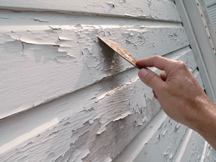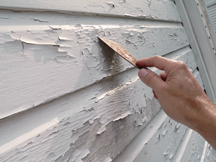

As you may have heard or read about in the news, starting April 22, 2010, all contractors performing renovation, repair, or painting on pre-1978 homes must be certified and follow specific work practices to prevent lead contamination. If you live in a house built before 1978, there's a good chance it contains lead paint.
We've received a number of questions from homeowners about this new U.S. Environmental Protection Agency (EPA) requirement and we wanted to share our answers with you.
1. How do I know if my house has lead paint?
If your house was built before 1978 assume that lead paint was used. According to the U.S. Consumer Product Safety Commission, about two-thirds of homes built before 1940 and about half of homes built between 1940 and 1960 contain heavily-leaded paint. Lead was used as a pigment and drying agent in alkyd oil-based paints until 1978 when the legal maximum of lead content in paints was reduced to a trace amount (0.06%). Lead paint can be on any interior or exterior surface, particularly on woodwork, doors, and windows. Latex or water-based paints generally have not contained lead.
2. What are the health risks attributed to lead paint exposure?
In most cases, lead-based paint that's in good condition is not a problem. As it deteriorates and breaks down into dust and chips, however, it can become a health risk. It can get into your body when dust is breathed in or swallowed, or by ingesting soil or paint chips that contain lead. Children are vulnerable to lead poisoning because their growing bodies absorb more lead and their brains and nervous systems are more sensitive to the damaging effects. Lead poisoning can cause irreversible brain damage and adversely impact development. In adults, lead poisoning can cause nerve damage, reproductive problems and high blood pressure. Removing lead-based paint improperly can increase your risk of exposure. Learn more about the health effects of lead on the EPA's Web site.
3. What does the EPA require from contractors?
The EPA requires all companies and contractors (including carpenters, painters, electricians, and window installers) who work on homes built before 1978 - to be certified in the use of lead-safe practices. EPA issues separate certifications to businesses and individuals. Upon completing an 8-hour EPA-approved course, contractors are certified for five years. All certified contractors must provide their clients with a copy of EPA's lead Hazard information pamphlet, "Renovate Right: Important Lead Hazard Information for Families, Child Care Providers, and Schools" and follow procedures to contain the work area, minimize dust, and clean up thoroughly.
4. What should I expect from my contractor?
EPA-certified contractors will explain the steps they will take to protect you from lead dust.
When they're working on the inside of your home, contractors must:
- Use signs to keep residents and pets out of the work area.
- Remove furniture and belongings, or cover them with heavy plastic sheeting.
- Use heavy plastic sheeting to cover floors and other fixtures (e.g., appliances) in the work area.
- When appropriate, use heavy plastic sheeting to separate the work area from other areas of the home.
- Close and seal vents in the work area and turn off forced-air heating and air conditioning systems.
To protect the work area outside of your home, contractors must:
- Mark off the work area to keep non-workers away.
- Cover the ground and plants with heavy plastic sheeting.
- Close windows and doors near the work area.
- Move or cover play areas near the work site.
- Wrap all removed materials in sealed plastic before taking them out of the work area.
- Use personal protective equipment to ensure the safety of workers.
- Provide you a list of all "trained workers."
Other precautions to minimize dust include:
- Misting areas prior to sanding, and scraping. Drilling or cutting.
- Scoring paint before separating components.
- Prying or pulling apart components instead of pounding and hammering.
- Using a shroud with a HEPA vacuum attachment when using power tools and equipment.
5. How much will this new rule add to the cost of my project?
The cost of complying with the new EPA regulations will depend on the type and size of the project you are undertaking. A baseline cost for all projects will take into account the contractor's cost for EPA certification, training, equipment, and required EPA documentation. For us, the minimum cost will be $100, even for the smallest jobs. On more extensive projects the cost could be thousands of dollars. Most contractors are just beginning to implement these regulations and may not know their exact costs until they have experience in fully meeting the requirements. If you are working with a qualified contractor, however, they should already be taking steps to protect your home and keep the job site clean, which will help facilitate compliance with the EPA requirements.
6. What if I do the work myself?
The EPA regulations do not apply to individual homeowners making their own repairs or painting their homes. However, if you suspect there is lead paint in your home or your home has tested positive for lead paint, take the time to read the EPA's "Renovate Right" brochure for information about how to work safely. Remember, common renovation activities such as sanding, demolition, and cutting can create lead dust by disturbing lead paint. If you're painting, prep work such as sanding, scraping, and using a "paint-burning" heater will also release lead dust and paint chips.
Related Posts
Painting Your Home’s Exterior: Choosing the Right Paint
Today's guest blogger is Paul Jones, Project Consultant for HomeRepair by McClurg. Paul has worked...
How to Choose the Right Replacement Windows for Your Home
Homeowners hear a lot about replacement windows in television ads. You may have even received...
Painting Your Home's Interior: 4 Tips for Choosing the Right Paint
Painting is one of the best and least expensive ways to update your home. A new paint job can...
